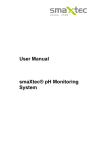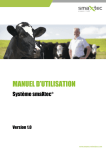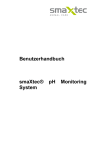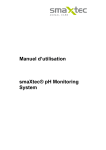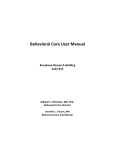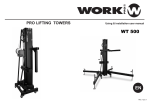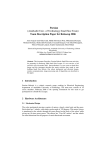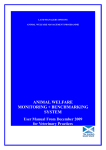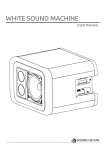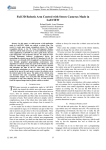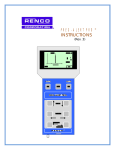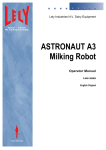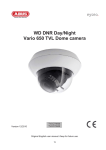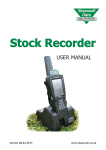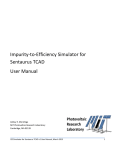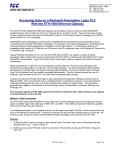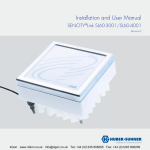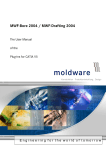Download Installation Manual - Downloads
Transcript
Installation manual Version 1.0 ©smaXtec animal care 11.05.2011 confidential Page 1 of 27 Table of contents 1 INTRODUCTION ........................................................................................................... 3 2 SCOPE OF SUPPLY ........................................................................................................ 4 3 BILL OF MATERIALS ..................................................................................................... 4 BASE STATION ..................................................................................................................... 4 ETHERNET/PATCH CABLE ....................................................................................................... 5 ETHERNET/PATCH CABLE CONNECTION ..................................................................................... 5 ANTENNA CABLES ................................................................................................................ 5 CABLE CONNECTOR MODEL 21_N‐50‐3‐8/133_N (FEMALE) FOR ANTENNA CABLE RG_223_/U OR ALTERNATIVE CABLE G_03212_D‐01 ............................................................................................ 5 3.6 CABLE CONNECTOR MODEL 11_N‐50‐3‐29 (MALE) FOR ANTENNA CABLE RG_223_/U OR ALTERNATIVE CABLE G_03212_D‐01 ............................................................................................ 6 3.7 ANTENNA AS433 (AUREL) .................................................................................................. 6 3.8 POWER SUPPLY ................................................................................................................... 7 3.1 3.2 3.3 3.4 3.5 4 ASSEMBLY ................................................................................................................... 8 4.1 4.2 4.3 4.4 4.5 4.6 4.7 4.8 GENERAL ........................................................................................................................... 8 FIXATION OF THE MOUNTING BRACKETS ................................................................................... 8 POSITIONING THE ANTENNAS ............................................................................................... 11 POSITIONING THE BASE STATION ........................................................................................... 13 LAYING THE ANTENNA CABLES .............................................................................................. 15 TESTING THE ANTENNA CABLES ............................................................................................. 16 LAYING THE ETHERNET/PATCH CABLE ..................................................................................... 16 STARTING‐ UP THE SYSTEM .................................................................................................. 17 5 INTERNET CONNECTION ............................................................................................ 18 6 APPENDIX .................................................................................................................. 19 6.1 6.2 6.3 6.4 6.5 ASSEMBLY INSTRUCTIONS 21_N‐50‐3‐8/133_N ................................................................... 19 ASSEMBLY INSTRUCTIONS 11_N‐50‐3‐29 ............................................................................. 20 ASSEMBLY INSTRUCTIONS HAN MAX‐M CABLE CONNECTOR ....................................................... 21 POSITIONING ANTENNAS AND BASE STATION IN DIFFERENT STABLES ............................................. 23 NECESSARY MATERIAL FOR THE INSTALLATION ......................................................................... 27 ©smaXtec animal care 11.05.2011 confidential Page 2 of 27 1 Introduction This installation manual contains information about an antenna receiver for a wireless data logger located in the rumen of livestock. A schematic illustration of the system is given in fig. 1. Fig. 1: Schematic illustration of the system 1. 2. 3. 4. 6. Pellet feeding station/milking station/massager Data logger in the rumen of livestock (hereinafter referred to as bolus) One/several antennas (433 MHz) receive the data from the data logger Base station saves the data on a server on the Internet (5.) Client PC accesses and interprets the measured data Prior to installing the antenna receiver, please refer to the information about each single component. The installation instructions in the Appendix for cables and/or plugs as well as examples for positioning both the antenna and the base station in different stables should be read carefully. ©smaXtec animal care 11.05.2011 confidential Page 3 of 27 2 Scope of supply In addition to the parts needed for installation (see Chapter 3. Bill of materials), the packaging contains an envelope (including a user manual, a smaXtec USB antenna and a magnet). This envelope should be given to the farmer. The packaging further includes a termination for the antenna (model 65_N-50-0-31/133_NE by Huber+Suhner) with which the antenna cables can be tested (see Chapter 4.6 Testing the antenna cables). 3 Bill of materials 3.1 Base station Fig. 2 shows a picture of the base station. Up to eight antennas may be connected to it in the course of installation. In addition the base station must be connected to the network or the client PC using Power Over Ethernet adapters and an Ethernet patch cable. Sockets connection for antenna Ethernet-/patch cable connection Fig. 2: Base station The optional UMTS antenna connection is located laterally, on the same side as the Ethernet/patch cable socket. ©smaXtec animal care 11.05.2011 confidential Page 4 of 27 3.2 Ethernet/patch cable For the connection between the base station and the Power Over Ethernet adapter as well as for the connection between the Power Over Ethernet adapter and the network (client PC), an Ethernet/patch cable, model • CAT 5e – UTP should be used. Cabling must be done in accordance with the TIA/EIA-568-B standard (regarding length, bending radius etc.). 3.3 Ethernet/patch cable connection To ensure a secure connection between the Ethernet/patch cable and the base station, a cable connector model Han Max-M should be used. For the corresponding assembly instructions please refer to Appendix 7.3. 3.4 Antenna cables The following antenna cables should be used For an antenna cable length of up to 50 m, a coaxial cable RG_223_/U from Huber+Suhner should be used. Make sure not to exceed the maximum bending radius during assembly (static case). This radius must be five times the outer diameter, in this case 30 mm. Lengths > 50 m should be avoided. 3.5 Cable connector model 21_N-50-3-8/133_N (female) for antenna cable RG_223_/U or alternative cable G_03212_D-01 Connect the cable connector 21_N-50-3-8-/133_N to the one end of the antenna cable RG_223_/U or alternative cable G_03212_D-01 (connection to antenna). For the corresponding assembly instructions refer to Appendix 7.1. ©smaXtec animal care 11.05.2011 confidential Page 5 of 27 3.6 Cable connector model 11_N-50-3-29 (male) for antenna cable RG_223_/U or alternative cable G_03212_D-01 Connect the cable connector 11_N-50-3-29 to the other end of the antenna cable RG_223_/U or alternative cable G_03212_D-01 (connection to base station). For the corresponding assembly instructions, refer to Appendix 7.2. 3.7 Antenna AS433 (AUREL) The antenna (including washer and screw nut) is supplied with a 20 cm long antenna cable RG_223_/U (or G_03212_D-01) Huber+Suhner, a coaxial cable and a 11_N50-3-29 (male) Huber+Suhner coaxial cable connector. Mounting brackets for installing the antennas in the stables are included with the antenna (Fig. 3). To install the antenna, so-called mounting brackets are used. A B A: Antenna B: Mounting Bracket E C: Antenna Cable D: Washer D E: Screw Nut C Fig. 3: AS433 Antenna parts ©smaXtec animal care 11.05.2011 confidential Page 6 of 27 3.8 Power supply Power to the base station is supplied via a Power Over Ethernet (PoE) adapter. For installation, only the specified adapter should be used (see Fig. 4). Fig. 4: Passive Power Over Ethernet adapter The PoE adapter comes with a mains adapter from wattac electronics (see Fig. 5). PLASE NOTE: This passive Power Over Ethernet adapter does NOT comply with the norm IEEE 802.3af. Fig. 5: Mains adapter wattac electronics Mains adapter specifications: Manufacturer: Wattac Electronics Model: BA0241C1-180-A03 Input: 100-240 V ~, 50/60 Hz, 0.7 A MAX Output: 18 V --- 1200 mA PLEASE NOTE: The PoE adapter and the mains adapter are not subject to IP norms concerning water protection, e.g. they must be by all means kept dry! If necessary, a 230V shock-proof female plug should be used for connecting the mains adapter that supplies the base station with power via the mains cable. ©smaXtec animal care 11.05.2011 confidential Page 7 of 27 4 Assembly 4.1 General When installing the cables, please refer to the forthcoming European Norm EN62305 (outdoor and indoor protection against lightning) which is especially important for cables leading from the interior to the exterior of a building (e.g. UMTS antenna). Such conductions should be protected from overvoltage. 4.2 Fixation of the mounting brackets Please separate the screw nut and the washer from the antenna (Chapter 3.7, Fig. 3) Now apply the mounting bracket to the antenna as shown in Fig. 6. Fig.6: Antenna Assembly (Step 1) Plug the antenna cable with the jagged side up (Fig. 7) on the antenna (Fig. 8). Fig. 7: Antenna Cable with Jagged Side Up ©smaXtec animal care 11.05.2011 confidential Page 8 of 27 Fig. 8: Antenna Assembly (Step 2) Apply the washer (Fig. 9) and afterwards the screw nut (Fig. 10) to the antenna and screw it together Fig. 4: Antenna Assembly (with washer, Step 3) ©smaXtec animal care 11.05.2011 confidential Page 9 of 27 Fig. 10: Antenna Assembly (with screw nut, Step 4) As the last step put the protection cap over the screw connection (Fig. 11). Fig. 11: Antenna Assembly (Step 5) ©smaXtec animal care 11.05.2011 confidential Page 10 of 27 4.3 Positioning the antennas It is possible to connect up to eight antennas to one base station. The antennas should be mounted in a place where the livestock rest for an extended period of time. The anntenas read out the boli in the livestock within a radius of 5 m. Typical locations are: • • • • Milking station Feeding station Massaging station Rest stop in front of milking station Antennas may be mounted at a height of 1 to 2 meters above the animal. The antenna must always be mounted to the left of the animal. Antennas placed behind or in front of the animal should be mounted parallel and in the viewing direction of the animal. Wherever the antennas are mounted directly above the animal (in any case to its lefthand side), the viewing direction of the antenna should correspond to the viewing direction of the animal. This would mean that the antenna points from above directly down to the animal (not parallel to it, but at an angle of 90°). Fig. 13 shows an antenna installed at an angle of 90° above livestock that are directly underneath. Fig. 14 shows a bar parallel to the animal, which is why the antenna was also mounted parallel to it. ©smaXtec animal care 11.05.2011 confidential Page 11 of 27 Fig. 13: Antenna oriented 90 degrees downwards Fig. 14: Antenna running parallel Wherever antennas are mounted to iron bars and/or electrically conductive bars, please make sure to insulate the mounting brackets using the supplied plastic pieces (see e.g. Fig. 15, Fig. 16). When using universal strap clamps, make sure to insulate them from the antenna mounts. Universal strap clamps are preferrable to PVC cable ties due to their reduced material fatigue. Fig. 15: Insulated mounting bracket fastened to an electrically conductive bar with insulating tape ©smaXtec animal care 11.05.2011 confidential Page 12 of 27 Fig. 16: Insulated mounting bracket with piece of wood 4.4 Positioning the base station The base station should be mounted in such a way that a cable with a maximum length of 50 m suffices to connect the antennas to the corresponding base station. Four screws are necessary to ensure a stable position. The width of the screw head must be between 8 and 8.4 mm in order to fit into the corresponding borings. Make sure to use stainless steel screws (V4A) since galvanized screws tend to corrode after a few years. The openings intended for assembly must be covered with special cover strips. These cover strips are included in the base station packaging. Fig. 17 and Fig. 18 show possible locations for the base station. ©smaXtec animal care 11.05.2011 confidential Page 13 of 27 Fig. 17: Base station mounted to wall Fig. 18: Base station mounted to pillar The base station in Fig. 18 was mounted to a pillar using a perforated metal plate (Fig. 19). ©smaXtec animal care 11.05.2011 confidential Page 14 of 27 Fig. 19: Fixation using perforated metal plate 4.5 Laying the antenna cables When laying the cables, make sure to avoid any pressure on them, e.g. from brackets or clamps etc. Cables connected to the base station and to antennas must not be taut and should neither hang by more than 1 m nor be under direct tension. An optimum solution would be to have a small loop before the actual connection point. In doing so, adhering to the bending radius instructions is essential. (see Chapter 2.4) Laying the cables inside empty tubes or cable trays etc. has also proven to be effective. As described in Chapters 2.5 and 2.6 above, the antenna cables RG_223_/U oder alternative G_03212_D-01 must be crimp-connected on one end with the cable connector model 21_N-50-3-8-/133_N (female), and on the other end with the cable connector model 11_N-50-3-29 (male). It is essential to use the crimping tool model 76_Z−0−0−15 (large) or model 75_Z−0−3−4/B2 (small) of Huber+Suhner, otherwise no liability may be assumed for successful cable contact. The cable connector model 21_N-50-3-8-/133_N (female) is connected to the antenna, and the cable connector model 11_N-50-3-29 (male) to the base station. Please note which antennas were connected to which socket of the base station. Fig. 20 shows the numberings at the base station. ©smaXtec animal care 11.05.2011 confidential Page 15 of 27 Fig. 20: Numberings of base station Antenna cables should not be mounted together with electric cables or other cables. 4.6 Testing the antenna cables Before connecting the antennas to the base station, it is necessary to test the cables. First connect the antenna cable to the termination (supplied by smaXtec) instead of the base station, and then test it using a multimeter. Approx. 50 Ohm should register between the internal and the external conductor. When unplugged, the termination should have infinite impedance. 4.7 Laying the Ethernet/patch cable The Ethernet cable model 5e–UTP is connected to the base station using the Han Max-M cable connector. To do this, refer to the assembly instructions in Appendix 5.3. For assembly, a crimp tool (model Ethernet Crimp Tool – CAT 5e UTP) should be used. The Ethernet/patch cable from the base station must be connected to the PoE adapter socket “POE”. Now ensure the “LAN“ connection with the network or client PC. To ensure the power supply of the PoE adapter the corresponding mains adapter (Fig. 6) must be connected to the “DC“ socket. The PoE adapter thus functions as interface to ensure the power supply to the base station by means of the Ethernet/patch cable. For a schematic illustration, see Fig. 21. We recommend installing the PoE adapter in the server room or in the room of the client PC (rather than the stables) in order to keep it dry. The Ethernet/patch cable should not be connected together with other conductions (e.g. electric cables etc.). ©smaXtec animal care 11.05.2011 confidential Page 16 of 27 Wattac Electronics Mains Adapter Fig. 21: Schematic illustration of the Ethernet cabling Cabling must comply with the norm TIA/EIA-568-B. 4.8 Starting- up the system The base station has been programmed beforehand and may be used once it is connected. The acceptance test is done using a testing programme supplied by smaXtec. To run this test, the base station must be integrated into the network – the necessary steps are described in the following chapter (Internet connection). ©smaXtec animal care 11.05.2011 confidential Page 17 of 27 5 Internet connection For the connection of the base station to the Internet, the following requirements must be met: • A DHCP router connected to the Internet must be installed on the base station network. • The DHCP service of the router must be activated and correctly set (usually with the default parameters of the router). • High ports (from 1024 upward) must NOT be blocked (the base station uses Port 1194 UDP). In order to test the Internet connection, download the connection test software from www.smaxtec-animalcare.com/install/Verbindung.zip and execute the file Verbindungstext.exe. This software will conduct the following tests: • Connection between client PC and base station • Connection between base station and switch (Internet connection to server) A functioning connection will be indicated by “OK”. If the connection between client PC and base station is “NOT OK“, check the following aspects: • If the LEDs at the base station are not lit (green should be on permanently and yellow should be blinking), check if the PoE adapter has been correctly installed (see Chapter 3.5) and replace it, if necessary. • Check the Ethernet cable from the client PC to the base station for defects. • Check Windows Firewall settings (either deactivate or set them correctly). • Check the DHCP settings of the router. If the connection between base station and switch is “NOT OK“, check the following aspects: • First check whether the Internet connection to your provider is working (using a PC or laptop computer). • Verify the DHCP settings of the router. • Check the Firewall settings of the router, e.g. whether ports from 1024 upwards connect through (e.g. if it is possible to unlock them for the public network and back). • Check the NAT settings of the router (they must be activated). ©smaXtec animal care 11.05.2011 confidential Page 18 of 27 6 Appendix 6.1 Assembly instructions 21_N-50-3-8/133_N ©smaXtec animal care 11.05.2011 confidential Page 19 of 27 6.2 Assembly instructions 11_N-50-3-29 ©smaXtec animal care 11.05.2011 confidential Page 20 of 27 6.3 Assembly instructions Han Max-M cable connector ©smaXtec animal care 11.05.2011 confidential Page 21 of 27 ©smaXtec animal care 11.05.2011 confidential Page 22 of 27 6.4 Positioning antennas and base station in different stables Example 1 ©smaXtec animal care 11.05.2011 confidential Page 23 of 27 Example 2 Internet connection pellet feeding station The milking room is designed for 2x6 cows. Low ceiling height. RG223 massager HOUSE 16 m 7 5 milking room6 34m 4 garage 7m 1 7m 2 7m 6m 3 5,4m base station 25 m antenna not only calving 50 m ©smaXtec animal care 11.05.2011 confidential Page 24 of 27 Example 3 ©smaXtec animal care 11.05.2011 confidential Page 25 of 27 Example 4 ©smaXtec animal care 11.05.2011 confidential Page 26 of 27 6.5 Necessary material for the installation For cabling of the base station the installation company must use and provide following material: • • • • Coax cable RG223/U or alternative cable G_03212_D-01 (ca. 150 m per barn) Cable connector model 11_N-50-3-29 (max. 8 per base station) Cable connector model 21_N-50-3-8-/133_N (max. 8 per base station) Crimping tool (model 76_Z−0−0−15 (large) or model 75_Z−0−3−4/B2 (small)) for mounting the cable connectors (model 11_N-50-3-29 and model 21_N-503-8-/133_N) with the coax cable RG223/U or alternative cable G_03212_D-01 (Cavity B2). • Ethernet cable (CAT5e-UTP) • Crimping tool (standard) for ethernet cable-connector The coax cable RG223/U (or alternative the cable G_03212_D-01), the cable connectors (model 11_N-50-3-29 and model 21_N-50-3-8-/133_N) and the crimping tool can be order by the company Huber + Suhner. Homepage and the contact person for German and Austrian customers you can find under: http://www.hubersuhner.com/ [email protected] +49 (0) 89 612 01-256 phone Jürgen Schäfer HUBER+SUHNER GmbH Mehlbeerenstraße 6 D- 82024 Taufkirchen, Germany The contact persons in other countries: - France (Mrs. Capra: +41 71 353-4668) - Netherlands (Mrs. Capra: +41 71 353-4668) - Denmark (Mrs. Hofstetter: +41 71 353-4032) - Italy (Mrs. Capra: +41 71 353-4668) - Finnland (Mrs. Hofstetter: +41 71 353-4032) ©smaXtec animal care 11.05.2011 confidential Page 27 of 27



























